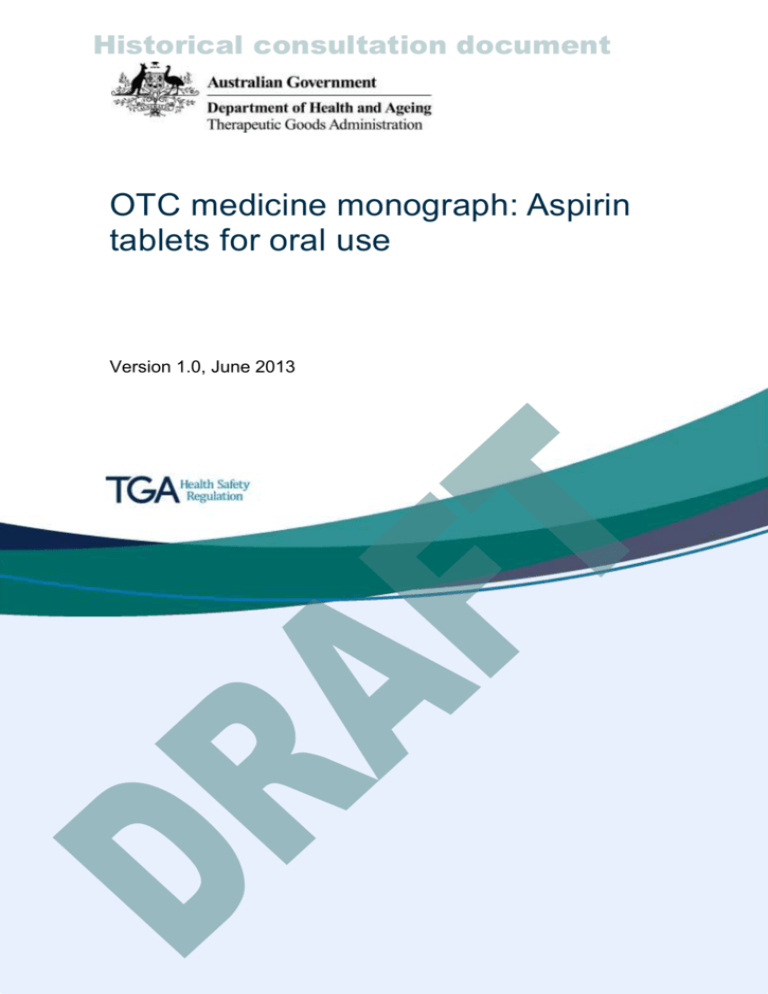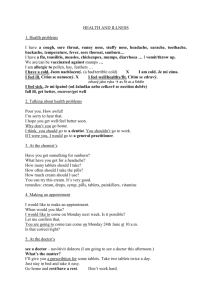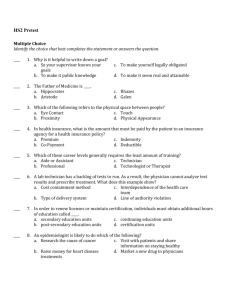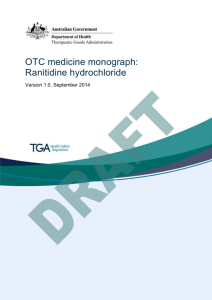
Historical consultation document
OTC medicine monograph: Aspirin
tablets for oral use
Version 1.0, June 2013
Historical consultation document
Therapeutic Goods Administration
About the Therapeutic Goods Administration (TGA)
The Therapeutic Goods Administration (TGA) is part of the Australian Government
Department of Health and Ageing, and is responsible for regulating medicines and
medical devices.
The TGA administers the Therapeutic Goods Act 1989 (the Act), applying a risk
management approach designed to ensure therapeutic goods supplied in Australia
meet acceptable standards of quality, safety and efficacy (performance), when
necessary.
The work of the TGA is based on applying scientific and clinical expertise to decisionmaking, to ensure that the benefits to consumers outweigh any risks associated with
the use of medicines and medical devices.
The TGA relies on the public, healthcare professionals and industry to report problems
with medicines or medical devices. TGA investigates reports received by it to
determine any necessary regulatory action.
To report a problem with a medicine or medical device, please see the information on
the TGA website <www.tga.gov.au>.
Copyright
© Commonwealth of Australia 2013
This work is copyright. You may reproduce the whole or part of this work in unaltered form for your own personal
use or, if you are part of an organisation, for internal use within your organisation, but only if you or your
organisation do not use the reproduction for any commercial purpose and retain this copyright notice and all
disclaimer notices as part of that reproduction. Apart from rights to use as permitted by the Copyright Act 1968 or
allowed by this copyright notice, all other rights are reserved and you are not allowed to reproduce the whole or any
part of this work in any way (electronic or otherwise) without first being given specific written permission from the
Commonwealth to do so. Requests and inquiries concerning reproduction and rights are to be sent to the TGA
Copyright Officer, Therapeutic Goods Administration, PO Box 100, Woden ACT 2606 or emailed to
<tga.copyright@tga.gov.au>
Confidentiality
All submissions received will be placed on the TGA’s Internet site, unless marked confidential. Any confidential
material contained within your submission should be provided under a separate cover and clearly marked “IN
CONFIDENCE”. Reasons for a claim to confidentiality must be included in the space provided on the TGA submission
coversheet. For submission made by individuals, all personal details, other than your name, will be removed from
your submission before it is published on the TGA’s Internet site. In addition, a list of parties making submissions will
be published. If you do not wish to be identified with your submission you must specifically request this in the space
provided on the submission coversheet.
Document title: Draft: OTC medicine monograph: Aspirin tablets for oral use
V1.0 June 2013
Page 2 of 11
Historical consultation document
Therapeutic Goods Administration
Version history
Version
Description of change
Author
Effective date
V1.0
Original Publication
OTC Medicines Evaluation
/OMA
18/06/13
Document title: Draft: OTC medicine monograph: Aspirin tablets for oral use
V1.0 June 2013
Page 3 of 11
Historical consultation document
Therapeutic Goods Administration
Contents
Introduction
5
Active substance, dosage forms and strengths
5
Active substance _____________________________________________________________ 5
Dosage forms and strengths________________________________________________ 5
Indications
6
Required therapeutic indications for inclusion in the Australian
Register of Therapeutic Goods (ARTG) ___________________________________ 6
Label indications _____________________________________________________________ 6
Directions for use
8
Adults and children 12 years and over* __________________________________ 8
Labelling
8
Quality requirements
8
Finished product specifications ___________________________________________ 9
Standard uncoated and chewable tablets ______________________________________________ 9
Dispersible tablets _______________________________________________________________________ 9
Effervescent tablets ______________________________________________________________________ 9
Enteric coated tablets____________________________________________________________________ 9
Container ___________________________________________________________________ 10
Document title: Draft: OTC medicine monograph: Aspirin tablets for oral use
V1.0 June 2013
Page 4 of 11
Historical consultation document
Therapeutic Goods Administration
Introduction
This OTC Medicine Monograph outlines the requirements for Australian market
authorisation of tablets containing aspirin as a single active ingredient when applied for as
an OTC New Product N2 application. Proposed products must comply with all aspects of
the monograph relevant to their strength and dosage form to qualify for evaluation as an
N2 application.
This monograph should be read in conjunction with the document Requirements for OTC
new product N2 applications.
Active substance, dosage
forms and strengths
Active substance
This monograph only applies to aspirin (acetylsalicylic acid; CAS No. 50-78-2) and
excludes preparations containing any salts and derivatives of aspirin.
Dosage forms and strengths
Acceptable dosage forms and strengths are shown in the table below.
Document title: Draft: OTC medicine monograph: Aspirin tablets for oral use
V1.0 June 2013
Page 5 of 11
Historical consultation document
Therapeutic Goods Administration
Active substance
Aspirin
Dosage
strengths
Dosage forms
100 mg
Tablets*
300 mg
Tablets*
500 mg
Tablets+
(excludes sustained release dosage
forms)
* Chewable, dispersible, effervescent, uncoated and enteric coated tablets only.
+ Chewable, dispersible, effervescent and uncoated tablets only.
Indications
Required therapeutic indications for inclusion in the
Australian Register of Therapeutic Goods (ARTG)
Required indications are shown in the table below.
Dosage form and
strength
Indications
100 mg tablets
For the treatment of patients with known cardiovascular or
cerebrovascular disease, as an antiplatelet agent for
prophylaxis against acute myocardial infarction, unstable
angina, transient ischaemic attack and cerebrovascular
accident (stroke).
300 mg or 500 mg
tablets
Temporary relief of pain associated with headache, migraine
headache, tension headache, sinus pain, toothache, dental
procedures, backache, muscular aches and pains, arthritis,
osteoarthritis, rheumatic pain, period pain, fibrositis,
neuralgia, sore throat, tennis elbow, and colds and flu.
Reduces fever.
Label indications
Acceptable label indications are shown in the table in the table below.
Document title: Draft: OTC medicine monograph: Aspirin tablets for oral use
V1.0 June 2013
Page 6 of 11
Historical consultation document
Therapeutic Goods Administration
Dosage form &
strength
Label indications
100 mg tablets
Reduces the risk of heart attack and stroke in patients with
known cardiovascular or cerebrovascular disease by helping to
prevent blood clotting.*
300 mg or 500 mg
tablets
All or some of the following indications may be included on
medicine labels:
For the temporary relief of pain and/or inflammation
associated with:
–
headache
–
rheumatic pain
–
migraine headache
–
–
tension headache
menstruation/period
pain
–
sinus pain
–
fibrositis
–
toothache
–
neuralgia
–
dental procedures
–
sore throat
–
backache
–
tennis elbow
–
muscular aches and
pains
–
symptoms of colds and
flu
–
arthritis
Reduces fever.
*Permission is required, under Section 42DK of the Therapeutic Goods Act 1989, for the use of claims
relating to the cardiovascular or cerebrovascular systems on product labelling. Include a request for
permission in the application cover letter.
Document title: Draft: OTC medicine monograph: Aspirin tablets for oral use
V1.0 June 2013
Page 7 of 11
Historical consultation document
Therapeutic Goods Administration
Directions for use
Adults and children 12 years and over*
Dosages must be as shown in the table below.
Dosage Form
& Strength
Single Dose
Dose Interval
Maximum Daily Dose
100 mg tablet
1 tablet
One tablet daily
100 mg
300 mg tablet
1-3 tablets
Every 4-6 hours
as required
Do not exceed 12 tablets
in 24 hours
500 mg tablet
1-2 tablets
Every 4-6 hours
as required
Do not exceed 8 tablets
in 24 hours
*A higher minimum age can also be specified (eg. Adults 18 years and over for 100 mg
tablets).
Enteric coated tablets should include the statement “Swallow whole. Do not crush or
chew”.
Labelling
Full scale, full colour draft labelling for each proposed pack size must be provided
electronically with the application, for assessment of the product’s presentation.
Labelling must comply with all relevant Australian requirements, as detailed in the
document Requirements for OTC new product N2 applications, including all required
warning statements.
Quality requirements
In addition to the requirements outlined in the document Requirements for OTC New
Product N2 applications, the following specific requirements apply to aspirin monograph
products:
Document title: Draft: OTC medicine monograph: Aspirin tablets for oral use
V1.0 June 2013
Page 8 of 11
Historical consultation document
Therapeutic Goods Administration
Finished product specifications
In addition to other requirements specified in the document Requirements for OTC new
product N2 applications, the finished product specifications must comply, at a minimum,
with one of the sets of requirements below, as relevant. The requirements below include
all relevant BP general monograph requirements and TGO78 requirements. Further
reference to these is not required.
Standard uncoated and chewable tablets
The tests and limits in the BP monograph Aspirin Tablets with the addition of:
tablet appearance
Uniformity of dosage units (BP)
dissolution (with a limit of ≥70% after 45 minutes)
tests and limits for microbiological quality, in compliance with TGO 77.
Dispersible tablets
The tests and limits in the BP monograph Dispersible Aspirin Tablets with the addition
of:
tablet appearance
Uniformity of dosage units (BP)
disintegration (as per the requirements for dispersible tablets in the BP general
monograph Tablets)
fineness of dispersion (as per the requirements for dispersible tablets in the BP
general monograph Tablets)
tests and limits for microbiological quality, in compliance with TGO 77.
Effervescent tablets
The tests and limits in the BP monograph Effervescent Soluble Aspirin Tablets with the
addition of:
tablet appearance
Uniformity of dosage units (BP)
tests and limits for microbiological quality, in compliance with TGO 77.
Enteric coated tablets
The tests and limits in the BP monograph Gastro-resistant Aspirin Tablets with the
addition of:
tablet appearance
As specified in the BP’s Supplementary Chapter 1E Dissolution Testing of Solid Oral Dosage Forms
Document title: Draft: OTC medicine monograph: Aspirin tablets for oral use
V1.0 June 2013
Page 9 of 11
Historical consultation document
Therapeutic Goods Administration
Uniformity of dosage units (BP)
dissolution (with a limit of ≤ 5% after 2 hours in acid and ≥ 70% after 45 minutes+ in
phosphate buffer)
tests and limits for microbiological quality, in compliance with TGO 77.
Container
Aspirin products must be sold in containers that comply with Therapeutic Goods Order No
80, Child Resistant Packaging Requirements for Medicines.
Document title: Draft: OTC medicine monograph: Aspirin tablets for oral use
V1.0 June 2013
Page 10 of 11
Historical consultation document
Therapeutic Goods Administration
PO Box 100 Woden ACT 2606 Australia
Email: info@tga.gov.au Phone: 1800 020 653 Fax: 02 6232 8605
www.tga.gov.au








